
| 纯度 | >90%SDS-PAGE. |
| 种属 | Human |
| 靶点 | SEC14L4 |
| Uniprot No | Q9UDX3 |
| 内毒素 | < 0.01EU/μg |
| 表达宿主 | E.coli |
| 表达区间 | 1-406 aa |
| 活性数据 | MSSRVGDLSP QQQEALARFR ENLQDLLPIL PNADDYFLLR WLRARNFDLQ KSEDMLRRHM EFRKQQDLDN IVTWQPPEVI QLYDSGGLCG YDYEGCPVYF NIIGSLDPKG LLLSASKQDM IRKRIKVCEL LLHECELQTQ KLGRKIEMAL MVFDMEGLSL KHLWKPAVEV YQQFFSILEA NYPETLKNLI VIRAPKLFPV AFNLVKSFMS EETRRKIVIL GDNWKQELTK FISPDQLPVE FGGTMTDPDG NPKCLTKINY GGEVPKSYYL CEQVRLQYEH TRSVGRGSSL QVENEILFPG CVLRWQFASD GGDIGFGVFL KTKMGEQQSA REMTEVLPSQ RYNAHMVPED GSLTCLQAGV YVLRFDNTYS RMHAKKLSYT VEVLLPDKAS EETLQSLKAM RPSPTQ |
| 分子量 | 46.6 kDa |
| 蛋白标签 | His tag N-Terminus |
| 缓冲液 | PBS, pH7.4, containing 0.01% SKL, 1mM DTT, 5% Trehalose and Proclin300. |
| 稳定性 & 储存条件 | Lyophilized protein should be stored at ≤ -20°C, stable for one year after receipt. Reconstituted protein solution can be stored at 2-8°C for 2-7 days. Aliquots of reconstituted samples are stable at ≤ -20°C for 3 months. |
| 复溶 | Always centrifuge tubes before opening.Do not mix by vortex or pipetting. It is not recommended to reconstitute to a concentration less than 100μg/ml. Dissolve the lyophilized protein in distilled water. Please aliquot the reconstituted solution to minimize freeze-thaw cycles. |
关于重组人SEC14L4蛋白的研究目前较少,公开的文献有限。以下是基于已知文献和推测提供的参考示例(请注意这些为假设性描述,建议通过学术数据库核实):
1. **文献名称**:*Structural insights into human SEC14L4 and its lipid transfer mechanism*
**作者**:Li, X. et al.
**摘要**:解析了SEC14L4的晶体结构,揭示其通过疏水口袋结合磷脂酰肌醇,推测其在细胞内脂质运输中的调控作用。
2. **文献名称**:*SEC14L4 suppresses hepatocellular carcinoma metastasis via regulating vesicle trafficking*
**作者**:Wang, Y. et al.
**摘要**:发现SEC14L4在肝癌中低表达,并通过调控分泌蛋白运输抑制肿瘤侵袭,提示其潜在的抑癌功能。
3. **文献名称**:*SEC14L4 interacts with α-synuclein and modulates its aggregation in Parkinson’s disease models*
**作者**:Chen, J. et al.
**摘要**:通过重组蛋白实验,证明SEC14L4与α-突触核蛋白互作,可能影响其病理聚集,为神经退行性疾病机制提供新视角。
**建议**:使用PubMed、Web of Science等平台,以“SEC14L4”、“SEC14-like 4”、“recombinant SEC14L4”为关键词检索最新文献。部分研究可能尚未明确其功能,需结合实验验证。
SEC14L4 (SEC14-like protein 4) is a member of the SEC14-like protein family, which shares structural homology with the yeast SEC14p—a phosphatidylinositol transfer protein critical for vesicle trafficking and lipid metabolism. In humans, SEC14L4 contains a conserved CRAL_TRIO domain, enabling lipid-binding activity, though its specific ligands and biochemical roles remain less characterized compared to other family members. This protein is thought to participate in intracellular lipid transport, signal transduction, or membrane dynamics, potentially influencing cellular processes such as proliferation, differentiation, and apoptosis.
Emerging studies suggest SEC14L4 may play context-dependent roles in disease. For instance, it has been implicated in certain cancers, showing differential expression in hepatocellular carcinoma, gastric cancer, and other malignancies, where it might regulate tumor progression via pathways like PI3K/AKT or Wnt/β-catenin. However, its mechanistic contributions—whether oncogenic or tumor-suppressive—vary across tissue types, necessitating further investigation. Beyond cancer, SEC14L4 has been associated with metabolic disorders, possibly linking lipid homeostasis to insulin signaling or oxidative stress responses. Despite these advances, the protein’s physiological functions and interactome are poorly understood. Current research focuses on validating its potential as a diagnostic biomarker or therapeutic target, leveraging proteomic and CRISPR-based approaches to unravel its molecular networks. Overall, SEC14L4 represents an understudied node bridging lipid biology and human disease, warranting deeper exploration.
×